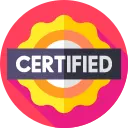FREE
daily Instructor: Dr. Amber RamosCourse Overview
Foundations of Computing
Computational Thinking and Problem Solving
- Understand the core principles of computational thinking, including decomposition, pattern recognition, abstraction, and algorithm design.
- Master problem breakdown techniques, transforming complex challenges into manageable sub-problems.
- Develop logical reasoning skills for constructing effective and efficient solutions to a wide range of computational problems.
Binary Representation and Logic
- Gain a deep understanding of binary, octal, hexadecimal number systems and their conversion.
- Explore Boolean algebra, logic gates (AND, OR, NOT, XOR, NAND, NOR), and their application in digital circuit design.
- Learn to design and analyze combinational and sequential logic circuits, forming the basis of computer hardware.
Programming Paradigms and Languages
Procedural Programming
- Master fundamental programming constructs such as variables, data types, operators, conditional statements (if-else, switch), and loops (for, while).
- Understand function declaration, definition, parameter passing mechanisms (by value, by reference), and recursion.
- Learn to organize code into modular, reusable components using structured programming techniques.
Object-Oriented Programming (OOP)
- Grasp core OOP concepts: encapsulation, inheritance, polymorphism, and abstraction.
- Design and implement classes, objects, interfaces, and abstract classes, applying principles like composition and aggregation.
- Utilize design patterns such as Singleton, Factory, and Observer to build robust, scalable, and maintainable software systems.
Functional Programming Concepts
- Understand the principles of immutability, pure functions, higher-order functions, and referential transparency.
- Explore concepts like lambda expressions, closures, and map/filter/reduce operations for concise and parallelizable code.
- Learn to reason about program correctness and avoid side effects in concurrent environments.
Data Structures and Algorithms
Fundamental Data Structures
- Master array-based structures: dynamic arrays, multi-dimensional arrays, and their memory layouts.
- Understand linked structures: singly, doubly, and circularly linked lists, and their manipulation for insertion, deletion, and traversal.
- Implement and apply abstract data types: stacks (LIFO), queues (FIFO), and deques using various underlying structures.
- Explore hash tables and hash functions, including collision resolution strategies like chaining and open addressing, for efficient data retrieval.
Advanced Data Structures
- Gain expertise in tree structures: binary trees, binary search trees (BSTs), AVL trees, red-black trees, and B-trees for balanced data storage and retrieval.
- Implement graph representations: adjacency matrices and adjacency lists, and understand their suitability for different problem types.
- Work with heaps (min-heap, max-heap) for priority queue implementations and efficient selection algorithms.
Algorithm Design and Analysis
- Understand time and space complexity analysis using Big O notation, Big Omega, and Big Theta for evaluating algorithm efficiency.
- Master searching algorithms: linear search, binary search, and hash-based searching.
- Implement and analyze sorting algorithms: bubble sort, selection sort, insertion sort, merge sort, quicksort, heap sort, and radix sort.
- Learn graph algorithms: Breadth-First Search (BFS), Depth-First Search (DFS), Dijkstra's algorithm for shortest paths, Prim's and Kruskal's algorithms for minimum spanning trees.
- Explore dynamic programming and greedy algorithms for solving optimization problems, recognizing their applicability and limitations.
Operating Systems
Operating System Concepts
- Understand the role and fundamental components of an operating system, including the kernel, shell, and system calls.
- Grasp process management: process states, Process Control Blocks (PCBs), process scheduling algorithms (FCFS, SJF, Priority, Round Robin), and context switching.
- Learn about inter-process communication (IPC) mechanisms: pipes, message queues, shared memory, and semaphores.
Memory Management
- Master concepts of virtual memory, paging, segmentation, and page replacement algorithms (LRU, FIFO, Optimal).
- Understand memory allocation strategies: contiguous allocation, buddy system, and slab allocation.
- Address memory protection mechanisms and memory-mapped files.
File Systems and I/O Management
- Explore file system structure: directories, file allocation methods (contiguous, linked, indexed), and free space management.
- Understand I/O hardware, polling, interrupts, Direct Memory Access (DMA), and buffering.
- Examine disk scheduling algorithms (FCFS, SSTF, SCAN, C-SCAN) for optimizing disk access.
Concurrency and Synchronization
- Identify and resolve race conditions, deadlocks, and starvation issues in concurrent programming.
- Implement synchronization mechanisms: mutexes, semaphores, monitors, and condition variables to ensure data integrity.
- Understand classic synchronization problems like the Producer-Consumer problem and Dining Philosophers.
Computer Architecture
Digital Logic and Representation
- Understand the building blocks of digital systems: gates, flip-flops, registers, and counters.
- Master data representation formats: signed and unsigned integers, floating-point numbers (IEEE 754 standard).
- Design and analyze basic arithmetic logic units (ALUs) for addition, subtraction, and logical operations.
CPU Organization and Design
- Explore the Von Neumann and Harvard architectures.
- Understand instruction set architectures (ISAs): RISC vs. CISC principles, instruction formats, and addressing modes.
- Grasp CPU components: control unit, arithmetic logic unit (ALU), registers, and program counter.
- Learn about pipelining: stages, hazards (structural, data, control), and techniques for hazard resolution.
Memory Hierarchy and Caching
- Understand the concept of a memory hierarchy: registers, caches (L1, L2, L3), main memory, and secondary storage.
- Master cache memory principles: cache lines, associativity (direct-mapped, set-associative, fully associative), write-back vs. write-through policies, and cache coherency protocols.
- Analyze cache performance metrics: hit rate, miss rate, and average memory access time.
I/O and Peripherals
- Understand I/O organization: programmed I/O, interrupt-driven I/O, and Direct Memory Access (DMA).
- Explore bus architectures: system bus, data bus, address bus, and control bus.
- Learn about various peripheral devices and their interfaces with the CPU.
Databases
Relational Database Management Systems (RDBMS)
- Master relational model concepts: tables, rows, columns, keys (primary, foreign, candidate), and referential integrity.
- Design relational schemas using Entity-Relationship (ER) diagrams and transform them into relational tables.
- Understand normalization forms (1NF, 2NF, 3NF, BCNF) to eliminate data redundancy and anomalies.
Structured Query Language (SQL)
- Gain expert proficiency in SQL for Data Definition Language (DDL): CREATE, ALTER, DROP.
- Master SQL for Data Manipulation Language (DML): SELECT, INSERT, UPDATE, DELETE statements, including complex queries with JOINs, subqueries, and aggregate functions.
- Understand SQL for Data Control Language (DCL): GRANT, REVOKE for managing user permissions.
- Implement transaction control using COMMIT, ROLLBACK, and SAVEPOINT.
Database Concurrency and Recovery
- Understand ACID properties (Atomicity, Consistency, Isolation, Durability) of database transactions.
- Explore concurrency control mechanisms: locking (two-phase locking), timestamp ordering, and optimistic concurrency control.
- Learn about database recovery techniques: logging, checkpoints, and shadow paging.
NoSQL Databases (Introduction)
- Understand the motivations and characteristics of NoSQL databases, including their scalability and flexibility.
- Explore different NoSQL categories: key-value stores, document stores, column-family stores, and graph databases.
- Grasp the CAP theorem (Consistency, Availability, Partition Tolerance) and its implications for distributed systems.
Computer Networks
Network Models and Protocols
- Understand the OSI (Open Systems Interconnection) and TCP/IP (Transmission Control Protocol/Internet Protocol) reference models and their respective layers.
- Gain expertise in the functionality and protocols at each layer, from the physical layer to the application layer.
- Analyze network packet structures and flow at different layers.
Network Devices and Topologies
- Identify and understand the roles of network devices: hubs, switches, routers, firewalls, and access points.
- Explore network topologies: bus, star, ring, mesh, and tree, and their advantages and disadvantages.
- Learn about different network types: Local Area Networks (LANs), Wide Area Networks (WANs), and their characteristics.
Core Networking Protocols
- Master IP addressing (IPv4 and IPv6), subnetting, and CIDR (Classless Inter-Domain Routing).
- Understand Address Resolution Protocol (ARP) and Internet Control Message Protocol (ICMP).
- Explore TCP (Transmission Control Protocol) for reliable, connection-oriented communication and UDP (User Datagram Protocol) for fast, connectionless communication.
- Learn about routing protocols: RIP, OSPF, BGP, and their operation.
Application Layer Protocols and Services
- Understand how common application protocols function: HTTP/HTTPS (web), DNS (domain name resolution), SMTP/POP3/IMAP (email), FTP/SFTP (file transfer).
- Explore client-server and peer-to-peer network architectures.
- Learn about socket programming for building network applications.
Software Engineering Principles
Software Development Life Cycle (SDLC)
- Understand various SDLC models: Waterfall, Agile (Scrum, Kanban), Spiral, and DevOps.
- Learn about requirements elicitation, analysis, specification, and validation techniques.
- Master software design principles: modularity, cohesion, coupling, and design patterns.
Testing and Quality Assurance
- Develop expertise in different testing levels: unit testing, integration testing, system testing, and acceptance testing.
- Implement various testing techniques: black-box testing, white-box testing, regression testing, and performance testing.
- Understand static analysis, code reviews, and debugging methodologies for identifying and resolving defects.
Version Control and Collaboration
- Master distributed version control systems like Git, including branching, merging, conflict resolution, and repository management.
- Learn collaborative development workflows: Gitflow, feature branching, and pull requests.
- Understand the importance of continuous integration and continuous delivery (CI/CD) pipelines.
Theoretical Computer Science
Automata Theory
- Understand formal languages and grammars: regular expressions, context-free grammars.
- Master finite automata (Deterministic Finite Automata - DFAs, Non-deterministic Finite Automata - NFAs) and pushdown automata.
- Grasp their application in language recognition, compiler design, and parsing.
Computability Theory
- Explore Turing machines as a universal model of computation.
- Understand the Church-Turing thesis and its implications for what can be computed.
- Learn about decidable and undecidable problems, including the Halting Problem, and their theoretical limitations.
Complexity Theory
- Differentiate between P, NP, NP-complete, and NP-hard complexity classes.
- Understand the significance of the P vs. NP problem and its impact on algorithm design and problem solvability.
- Analyze the intrinsic difficulty of computational problems.
Artificial Intelligence and Machine Learning Fundamentals
Introduction to AI Concepts
- Understand the core goals and historical development of Artificial Intelligence.
- Explore different types of AI: symbolic AI, connectionist AI, and hybrid approaches.
- Grasp concepts of intelligent agents, problem-solving agents, and their architectures.
Machine Learning Basics
- Differentiate between supervised learning (classification, regression), unsupervised learning (clustering, dimensionality reduction), and reinforcement learning.
- Understand fundamental concepts like training data, testing data, overfitting, underfitting, bias-variance trade-off, and cross-validation.
- Explore basic algorithms such as linear regression, k-Nearest Neighbors (k-NN), decision trees, and Naive Bayes classifiers.
Knowledge Representation and Search
- Learn about various knowledge representation techniques: propositional logic, first-order logic, semantic networks, and frames.
- Master informed and uninformed search algorithms: Breadth-First Search (BFS), Depth-First Search (DFS), Asearch, and minimax for game playing.
Cybersecurity Fundamentals
Principles of Information Security
- Understand the core principles of Confidentiality, Integrity, and Availability (CIA triad).
- Learn about common security threats: malware, phishing, denial-of-service, man-in-the-middle attacks.
- Explore defense-in-depth strategies and security policies.
Cryptography Basics
- Grasp symmetric-key cryptography (AES, DES) and asymmetric-key cryptography (RSA, ECC).
- Understand hashing functions (SHA-256, MD5) for data integrity and digital signatures for authentication and non-repudiation.
- Learn about Public Key Infrastructure (PKI) and X.509 certificates.
Network Security
- Understand firewall types (packet filtering, stateful inspection, application layer) and intrusion detection/prevention systems (IDS/IPS).
- Explore Virtual Private Networks (VPNs) and secure communication protocols like SSL/TLS.
- Learn about common network attack vectors and countermeasures.
FlashCards
External Resources
Add-On Features
Expert Instructor
Get live study sessions from experts
Honorary Certification
Receive a certificate before completing the course.
Currency
Sign in to change your currency
I'm not ready to enroll?
Tell us why, because it matters.
Enroll With a Key
Course Benefits
Get a Job
Use your certificate to stand out and secure new job opportunities.
Earn More
Prove your skills to secure promotions and strengthen your case for higher pay
Learn a Skill
Build knowledge that stays with you and works in real life.
Lead Teams
Use your certificate to earn leadership roles and invitations to industry events.
Visa Support
Use your certificate as proof of skills to support work visa and immigration applications.
Work on Big Projects
Use your certificate to qualify for government projects, enterprise contracts, and tenders requiring formal credentials.
Win Partnerships
Use your certified expertise to attract investors, get grants, and form partnerships.
Join Networks
Use your certificate to qualify for professional associations, advisory boards, and consulting opportunities.
Stand Out Professionally
Share your certificate on LinkedIn, add it to your CV, portfolio, job applications, or professional documents.
Discussion Forum
Join the discussion!
No comments yet. Sign in to share your thoughts and connect with fellow learners.
Frequently Asked Questions
For detailed information about our Computer Science course, including what you’ll learn and course objectives, please visit the "About This Course" section on this page.
The course is online, but you can select Networking Events at enrollment to meet people in person. This feature may not always be available.
We don’t have a physical office because the course is fully online. However, we partner with training providers worldwide to offer in-person sessions. You can arrange this by contacting us first and selecting features like Networking Events or Expert Instructors when enrolling.
Contact us to arrange one.
This course is accredited by Govur University, and we also offer accreditation to organizations and businesses through Govur Accreditation. For more information, visit our Accreditation Page.
Dr. Amber Ramos is the official representative for the Computer Science course and is responsible for reviewing and scoring exam submissions. If you'd like guidance from a live instructor, you can select that option during enrollment.
The course doesn't have a fixed duration. It has 25 questions, and each question takes about 5 to 30 minutes to answer. You’ll receive your certificate once you’ve successfully answered most of the questions. Learn more here.
The course is always available, so you can start at any time that works for you!
We partner with various organizations to curate and select the best networking events, webinars, and instructor Q&A sessions throughout the year. You’ll receive more information about these opportunities when you enroll. This feature may not always be available.
You will receive a Certificate of Excellence when you score 75% or higher in the course, showing that you have learned about the course.
An Honorary Certificate allows you to receive a Certificate of Commitment right after enrolling, even if you haven’t finished the course. It’s ideal for busy professionals who need certification quickly but plan to complete the course later.
The price is based on your enrollment duration and selected features. Discounts increase with more days and features. You can also choose from plans for bundled options.
Choose a duration that fits your schedule. You can enroll for up to 180 days at a time.
No, you won't. Once you earn your certificate, you retain access to it and the completed exercises for life, even after your subscription expires. However, to take new exercises, you'll need to re-enroll if your subscription has run out.
To verify a certificate, visit the Verify Certificate page on our website and enter the 12-digit certificate ID. You can then confirm the authenticity of the certificate and review details such as the enrollment date, completed exercises, and their corresponding levels and scores.
Can't find answers to your questions?
Additional Courses
- 1.1k View
- 14 Questions
- 554 Views
- 24 Questions
- 135 Views
- 25 Questions
- 839 Views
- 23 Questions
- 1.4k View
- 24 Questions
Certification Guide

Complete the Course
Begin the course by selecting your experience level in the course content section:
Beginner: Master the material with interactive questions and enough time.
Intermediate: Get certified faster with hints and balanced questions.
Advanced: Challenge yourself with more questions and less time

Earn Your Certificate
To download and share your certificate, you must achieve a combined score of at least 75% on all questions answered.





